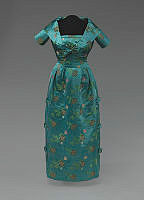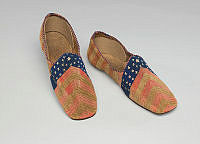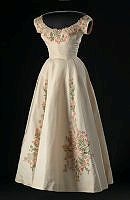Rubenstein Center Scholarship
"liberated & set free at Mr. Monroe's dying request": Peter Marks' White House Story
This article is part of the Slavery in the President’s Neighborhood initiative. Explore the Timeline
On July 4, 1831, President James Monroe died after months of illness. Many Americans mourned the loss of the last “Founding Father” president. But for one man, Peter Marks, the impact of Monroe’s death was very different.
Peter Marks (sometimes spelled Marx) was enslaved in Monroe’s household for most of his life. Sometime in the final few months of his life, Monroe made a “dying request” that Marks be given his freedom. He was the only enslaved person Monroe ever freed. We know of Marks’ manumission because a month after the former president’s death, Tench Ringgold, a friend of Monroe’s, wrote the following recommendation to help Marks find employment as a free man in Washington, DC:
“The bearer hearof Peter Marks a coloured man late the property of James Monroe deceased, late President of the United States, has been liberated & set free by at Mr Monroes dying request by his executor Samuel L. Gouverneur of the City of New York & by Mrs E K Hay one of Mr Monroes daughters to whom he was a slave.
Peter is honest, and capable, he is an excellent dining room serv[an]t, and a good coachman, has been brought [up in] the family of Mr Monroe from his infancy ea[rly l]ife & I can recommend him to any person [who ma]y want a waiter or coachman, as I have long [know]n him.”1

Eugenia and Peter Marks settled their family in Northeast Philadelphia, pictured here in an 1843 map of the city.
Library of CongressWhile it is difficult to definitively prove, Marks likely lived and worked at the White House during Monroe’s presidency. The 1820 census tells us that Monroe had at least six enslaved individuals in his White House household at that time: two men between the ages of fourteen and twenty-five, two men between the ages of twenty-six and forty-four, one man aged forty-five or older, and one woman aged forty-five or above.2 Marks was around twenty-five at the time, right on the cusp between two age brackets, so any of the first four men listed could plausibly have been him. Another household record provides at least circumstantial evidence of Marks’ presence at the White House: a financial record noting the purchase of clothes and shoes for enslaved men named Tom, Daniel, Hartford, and Peter.3 It’s certainly not impossible that Monroe owned more than one enslaved man named Peter, but it is relatively unlikely. Click here to learn more about the enslaved household of President James Monroe.
Ringgold’s detailed recommendation also strongly suggests that Marks would have been one of the individuals listed in the 1820 census. He describes Marks as a skilled dining room servant and coachman, both essential duties to the domestic life of the Monroe family. There is no evidence Monroe left Marks behind at Highland and Monroe would have required someone with Marks’s skillset at the White House. Bringing Marks would also have been the logical financial decision for the Monroes – exploiting the unpaid labor of an enslaved person like Peter Marks was considerably less expensive than hiring free servants to do the same job.
Other details further suggest that Marks accompanied Monroe to the White House. Tench Ringgold lived and worked in Washington, D.C. during and after Monroe’s presidency, as Monroe had appointed him U.S. Marshal for the District of Columbia. If Ringgold knew Peter Marks well enough to recommend him to potential employers, it is likely that they met in Washington, either at the White House or on one of Monroe’s visits to Ringgold’s home. Finally, it is telling that Marks was the only enslaved person James Monroe ever freed. When other early presidents freed one or a small number of enslaved people, they were almost always valets or other close members of the domestic household. Thomas Jefferson freed his manservant Burwell Colbert. George Washington freed his longtime valet William Lee.4 Since Monroe only freed Peter Marks, one can assume that Marks worked closely with him. Given that context, it is almost certain that Marks would have been one of those six enslaved people working at White House in 1820. Click here to learn more about the enslaved household of President George Washington. Click here to learn more about the enslaved household of President Thomas Jefferson.

The final census recording for Eugenia Marks occurred in 1880 when she was listed living in Philadelphia with her grandson Jacob Tilghman at the age of seventy-seven.
AncestryPeter Marks had another unusual connection to the presidency. His wife, Eugenia Hemings Marks, belonged to President Thomas Jefferson, although she never worked in the White House. After Jefferson’s death in 1826, she was bequeathed to his daughter, Martha Jefferson Randolph, and later to his granddaughter, Cornelia J. Randolph. In 1833, Cornelia sold Eugenia to Major Alfred Mordecai of the United States Arsenal in Washington, D.C, where Eugenia worked as his housekeeper and cook.5 In Washington, Eugenia likely met and married Peter Marks, who had returned to the city after Monroe’s death in search of work, though it is possible that they already knew each other before they arrived in the capital. Monroe admired Jefferson as a friend and mentor, and because Monticello and Highland were only a few miles apart, Monroe visited him often.6 Monroe might have brought Marks on those trips as a servant, in which case Marks would have had ample opportunity to form relationships with Monticello’s enslaved community.
In 1835, four years after Peter received his freedom, the two had a son, James. At least four other children followed. They made their way to Philadelphia, where Peter Marks worked as a waiter, just as he had likely done in the White House. This time he earned wages. The family’s record from the 1850 census suggests that all the children after James were born in Pennsylvania, which would have put their departure from Washington, D.C. around 1836. However, Major Mordecai did not manumit Eugenia and her children until 1839.7 It is possible that Peter, Eugenia, and their family had escaped to Philadelphia, and that after a few years Major Mordecai simply gave up trying to get them back. They might also have made an agreement with Mordecai to allow them to go in exchange for paying off Eugenia’s freedom. It is also possible that the census-taker simply recorded the children’s birthplaces wrong, and that the Marks family did not move to Philadelphia until after 1839. What we know for sure is that by 1850, Peter and Eugenia were living free in Philadelphia with James (age 15), Mary Ann (14), Eugene (12), Elizabeth (11), and Edward (6).

After gaining his freedom, Peter Marks and his family settled in Philadelphia.
There is little other information about Peter and Eugenia Marks’ life and marriage beyond what appeared in newspapers in the 1870s and 1880s, during Eugenia’s old age or at the time of her death. Columnists noted the coincidence of two enslaved people from different presidential households ending up together, but also promoted a positive, whitewashed view of slavery common in that era. Many described Major Mordecai as Eugenia’s “greatest benefactor and friend” for freeing her and detailed the many powerful men Eugenia had the opportunity to cook for and wait on while she was enslaved.8 One article, published in 1873, described Peter Marks in glowing terms as “a sort of prime minister behind the scenes” during Monroe’s time in the White House.9 These articles provide interesting anecdotes related to the Marks’ story, but given the decades that had passed since Monroe’s presidency, and the often exaggerated language used in the articles, we should be wary of taking any of their claims as definitive fact.
The final official record of Peter Marks’ life is tragic. A Philadelphia census record for “Persons who Died during the Year ending 1st June 1860” listed both Peter Marks, age sixty-five, and his son James, age twenty-five, among the deceased. They died only a few months apart, of apparently unrelated illnesses. Neither lived to see the end of slavery in the United States. An annotation by the record keeper noted that Peter Marks was a manumitted slave of President James Monroe, “quite an aristocrat among the colored people, and much respected by the whites.”10 Although the language is somewhat condescending, the fact that the note was made at all is remarkable. No one else in the Marks’ ward was singled out in such a way in the records. In the free city of Philadelphia, with its substantial free black population, Peter and Eugenia Marks found a degree of community that slavery had previously denied them. Although she lost her husband and eldest child relatively young, Eugenia Marks lived into her eighties, residing with her daughter and then with her grandson, supported by the free family she had built.11










